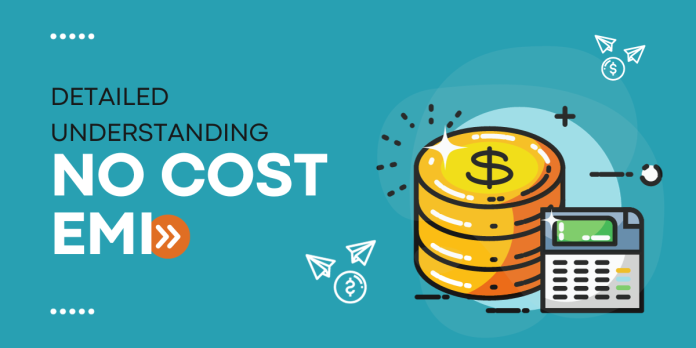In the world of consumerism, the desire to own high-value items often clashes with the financial constraints faced by individuals. The introduction of innovative financing schemes like ‘No-Cost EMI’ has emerged as a game-changer, offering a pathway for shoppers to acquire pricey items without the burden of hefty upfront payments. This article delves into the intricacies of No-Cost EMI, comparing it with the conventional Regular EMI, and sheds light on its benefits and drawbacks.
Understanding No-Cost EMI
No-cost EMI stands as a beacon of financial accessibility, allowing individuals to break down the cost of a product into affordable monthly instalments without incurring additional interest charges. Unlike Regular EMI plans that often come with interest rates above 5%, No-Cost EMI plans offer a 0% interest rate, making it an attractive proposition for budget-conscious consumers.
Read: Flat Vs Reducing Interest Rates
In a Regular EMI scenario, the total cost includes both the product price and the accrued interest, resulting in a higher overall expenditure. On the contrary, No-Cost EMI plans ensure that you only pay the product price over the chosen tenure, providing financial relief without compromising on your desired purchase.
Comparing Regular EMI and No-Cost EMI
Let’s unravel the differences between Regular EMI and No-Cost EMI using a simple example:
Consider a smartphone with a price tag of Rs. 20,000. With a Regular EMI plan over 6 months and an assumed interest rate of 10%, the total cost becomes Rs. 21,000, leading to a monthly EMI of Rs. 3,500.
In contrast, a No-Cost EMI plan may offer a discount of Rs. 1,000 on the smartphone, making the effective cost Rs. 19,000. The monthly EMI for No-Cost EMI would then be Rs. 3,166.67, significantly lower than the Regular EMI.
Advantages and Disadvantages:
Advantages:
- No Additional Charges: No-Cost EMI plans spare consumers from additional charges such as interest or processing fees, ensuring transparency in financial transactions.
- Affordability: By converting the cost into interest-free EMIs, No-Cost EMI plans make high-value purchases more accessible and manageable for individuals with budget constraints.
- Flexible Options: No-Cost EMI plans are widely available across various platforms, providing flexibility regardless of the bank or card type, and catering to diverse personal needs.
- Versatile Usage: These plans can be utilised for various purposes, including celebrations, education expenses, and more.
Disadvantages:
- Higher Overall Cost: Regular EMI plans may result in a higher overall cost due to added interest, which could discourage some customers.
- Limited Discounts: Discounts or cashback offered with No-Cost EMI plans may be lower than potential interest charges, and these options may not be available for all products.
- Customer Preferences: Some customers may prefer upfront discounts instead of No-Cost EMI, impacting the attractiveness of the scheme.
Credit Card Usage in No-Cost EMI
Both Regular EMI and No-Cost EMI plans deduct the purchase amount from the credit limit. However, in the case of No-Cost EMI, it deducts the discounted product cost, preserving more of the credit limit for other transactions.
Comparison Summary: Regular EMI vs. No-Cost EMITop of Form
| Aspect | Regular EMI | No-Cost EMI |
| Product Cost | Same | Same |
| Interest Rate | above 5% most of the cases | 0% |
| Total Cost | (Product + Interest) | Product |
| Monthly EMI Amount | (Product cost + Interest) divided by Months | Product cost divided by Months (No Interest) |
| Advantages | · Allows spreading the cost over time. | · No additional charges (interest or processing fees). |
| · Quick access to the product. | · Affordability with interest-free payments. | |
| · Helps build credit. | · Flexible options across various platforms. Versatile usage for personal needs. | |
| Disadvantages | · Higher overall cost due to added interest. | · Discounts or cashback may be lower than potential interest charges. |
| · May discourage some customers due to interest charges. | · No-Cost EMI options may not be available for all products. | |
| · Some customers may prefer upfront discounts instead of No-Cost EMI. | ||
| Credit Card Usage | Deducts from credit limit for the full product cost. | Deducts from credit limit for the discounted product cost. |
There are a few different ways through which one can take advantage of no-cost EMI:
- Make a fixed deposit and use the interest income to offset the EMI payments: This is a good option for customers who have the cash on hand to make the fixed deposit and who are comfortable with the risk of locking up their funds for a period of time.
- Use a credit card that offers no-cost EMI: Many credit cards offer no-cost EMI options on purchases made at certain retailers or on specific categories of goods.
- Take out a personal loan with a no-cost EMI option: Personal loans can be used to finance a variety of purchases, including electronics, furniture, and appliances. Some lenders offer no-cost EMI options on personal loans, which can be a good way to spread out the payments over time.
- Utilize a cashback credit card for no-cost EMI: If you have a cashback credit card, you can use the cashback rewards to offset the cost of the EMI payments. This can effectively reduce the overall cost of the purchase.
- Negotiate with the retailer for a no-cost EMI option: In some cases, you may be able to negotiate with the retailer for a no-cost EMI option, even if they don’t typically offer it. This is more likely to be successful if you are a good customer and have a history of making on-time payments.
When deciding between no-cost EMI and other payment options, consider your budget to ensure monthly instalments align with your financial situation. Evaluate if the additional cost of no-cost EMI justifies the product’s value. Compare with upfront discounts or lower-interest EMI plans for a well-informed choice. This ensures a financially prudent decision aligned with your goals.


